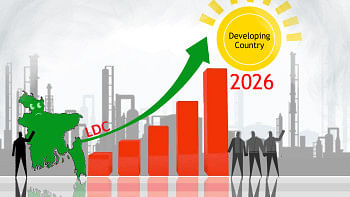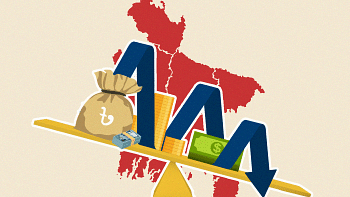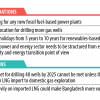What the budget means for Bangladesh’s trade policy direction

While fiscal and monetary policy implications of the FY2025 budget are easy to untangle, one needs to drill down deeper to decipher the true stance and direction of trade policy, as immersed in the budget.
As a trade economist, a focus on the government's articulation of trade policy under the rubric of annual budgets has been my raison d'etre for a post-budget column for the past several years. This time is no exception. But it took on greater importance this time in light of the fact that the economy is faced with a number of critical challenges that deserved immediate attention. Regrettably, trade policy has often not been on the radar.
It is fair to say that the domestic side of the equation has been adroitly addressed through a combination of fiscal restraint and a constricted fiscal deficit to complement the inflation-reduction stance of the monetary policy already under way. On the external side, restoring stability in the balance of payments was partly addressed in the weeks preceding the budget presentation by moving to a flexible exchange rate regime—the crawling peg—along with a modest depreciation of the taka on top of the massive depreciation already enacted over the previous 18 months. All eyes have been glued to the one salient macroeconomic indicator of external stability—official foreign exchange reserves.
A pivotal step towards stabilising forex reserves was the move by the central bank to launch a regime of exchange rate flexibility (a component of trade policy) shortly before the budget announcement. Technically, Bangladesh has been on a floating exchange rate regime since 2004, when this sort of exchange rate system was officially launched.
A freely floating exchange rate system is the epitome of exchange rate flexibility. If allowed to function, the exchange rate will depreciate when there is an excess demand (via imports) for foreign exchange and will appreciate when there is an excess supply (via exports) of foreign exchange. Thus, this system contains a built-in adjustment process (not instantaneous but over a period) for restoring balance in trade or current account deficits or even the entire balance of payments. Usually, most economies subscribing to the floating exchange rate system adhere to what is called a "managed float". The devil lies in the degree of management of the float. In our case, the managed float became so entrenched over time that the system failed to respond to changes in demand and supply, approaching a fixed exchange rate system around 2020-2022. The exchange rate became significantly over-valued making exports uncompetitive. One indication of this over-valuation was the appreciation of the Real Effective Exchange Rate (REER), a measure of export competitiveness, by over 50 percent compared to 2011.
In FY2022, the dam broke, as it were, and Bangladesh Bank could not avoid letting the exchange rate depreciate a massive 30 percent during 2023, and another 6 percent in a pre-budget adjustment in May 2024. Such a significant one-time depreciation—rather than gradual depreciation over several years—is disruptive and causes a shock to various parts of the economy. The shock—inflation, depleting foreign exchange reserves, import curbs, balance of payments volatility—had to be mollified with bold measures to restore macroeconomic stability. Unfortunately, for the economy, those measures came late in the day, only in the last three to six months, with the finishing touches to be expected from the FY2025 budget. So, it would be fair to commend the budget policymakers, headed by the Finance Minister, for deftly putting the finishing touches on restoration of macroeconomic stability, both internal and external, in order to move forward on a path of stable and rising growth that was the stock of the Bangladesh economy for three decades.
Yet, in my view, some more proactivity would have been desirable on the trade policy front given that forex reserves had barely stabilised at about three and a half months of import cover whereas the dire need is to restore a comfortable zone for forex reserves at around five or more months of import cover. Aggressive measures are needed to boost reserves by providing impetus for export growth and remittance inflows. This is where trade policy direction becomes vital for providing the right stimulus to exports.
Already, the first step towards stimulating exports has been taken, with the substantial depreciation of the exchange rate that has pretty much eliminated the past appreciation of REER. But one fundamental policy that favours domestic sales over exports—anti-export bias of tariffs—remained unaddressed, though a rare opportunity was presented by the depreciation-induced tariff spike across-the-board (36 percent depreciation raised all tariffs by 36 percent). It presented the scope for drastic rationalisation of tariffs without the revenue loss implications that continue to haunt the revenue authority.
The persistence of anti-export bias emerges from the high tariff protection regime intended to prop up domestic import substitution industries (ISIs), which then serves to discourage export activity because they become less profitable relative to domestic sales. There was high expectation that, following so much discussion on the subject over the past year, the budget, which usually lays down the magnitude and direction of tariff adjustments (indicating trade policy direction), would be aggressively moving to purge anti-export bias of tariff protection in a substantial degree. Indeed, there is a hint that this might be in the offing as the FM's budget speech highlights the formulation of National Tariff Policy 2023 which, if implemented in whole or in part, could open the doors for export diversification, enhance product competitiveness, rationalise tariffs for reducing anti-export bias and ensuring balanced development of import substituting industries. As no implementation programme for NTP 2023 was noticeable in the budget speech, perhaps the program will be undertaken subsequently, as media reports suggest.
If anything, tariff rationalisation was modest as Regulatory Duty (RD) and Supplementary Duty (SD) were withdrawn from 110 tariff lines. The surprising element was the reduction of SD on 172 RMG tariff lines, from 45 percent to 30 percent. Why not completely eliminate SD on RMG imports? Do we really need protective tariff for RMG when we are the second largest exporters of apparel in the world? The budget also lays down some feeble tariff rationalisation measures in light of the impending LDC graduation when what was needed was aggressive action. For instance, as 90 percent of SD are applied for protection purposes (higher rates on imports, lower or nil SD on domestic production), this could run afoul of WTO compliance. Though we can hope for some "due restraint" on the part of WTO members following graduation, the prospect of anti-dumping or countervailing duties cannot be ruled out. An opportunity was thus missed to move aggressively on the tariff rationalisation path.
A notable innovation was the promotion of brand Bangladesh through the emphasis on "Made in Bangladesh" strategy for giving stimulus to "domestic industries." What is not clear from the budget is what strand of this strategy do the policymakers espouse? There are two strands to this trade policy strategy: (a) MADE IN BANGLADESH, SELL IN BANGLADESH and (b) MADE IN BANGLADESH, SELL IN THE WORLD MARKET.
My reading of the support measures seems to suggest that the preferred policy is geared to the former dispensation. Although export-oriented sectors are also on the radar, the budget seems to focus on promoting several import substituting industries with protection support—raising output tariffs and lowering input tariffs —in a classic demonstration of raising effective protection and, thereby, discouraging exports of the same products via anti-export incentive bias.
This is where history of trade and development diverges. The first strand of trade policy, by focusing on the domestic market, has never given growth rates of seven to eight percent on a sustained basis anywhere in the world. There is no historical or cross-country evidence of this happening. No matter how large the domestic market is, it is no match to the size and scale of the world market. It is the second strand of trade policy that has the potential to generate seven, eight, nine percent or even higher growth rates by harnessing the demand of the massive global market. China, Vietnam and several East Asian countries are classic examples of turning around poor economies into high growth, high income economies within a few decades. Should Bangladesh not opt for the second orientation of trade policy? Moreover, there is clear evidence that export-oriented industrialisation creates much greater employment than import substituting, domestic market driven industrialisation. In our country, RMG is a case in point.
The budget may not be the place to articulate the entire strategy for trade policy directions as the country moves into the LDC graduation phase of development. This post-budget note is meant to underscore the urgency of the task ahead, lest we reach a cliffhanger on November 24, 2026—the date for graduation out of LDC status. A crisis always presents opportunities to be seized. In 1990, when the economy faced a macroeconomic and balance of payments crisis, the country's policymakers chose to go for radical trade policy reforms, investment liberalisation, and market-oriented reforms. These reforms, though ostensibly incomplete, still gave the impetus for two decades of rapid growth and poverty reduction. Given that the economy is once again faced with heightened degree of macroeconomic and balance of payments challenges, and LDC graduation is imminent, one would be looking for another round of structural reforms at least in the long overdue trade and tax policy arenas in order to restore macroeconomic and balance of payments stability and resume its long-run rapid growth path.
With regard to a medium-term development strategy, the budget may not be the end game. There are signs of change in trade policy directions, but our hope was for more clarity and aggression in moving forward with change. Maybe that part of the agenda for action has been left for post-budget activities.
It is important to recognise that trade has been the handmaiden of Bangladesh's development. It will remain so for the next decade and beyond. So, adopting the most dynamic trade policy for future progress is a national imperative now.
Dr Zaidi Sattar is Chairman, Policy Research Institute of Bangladesh (PRI).
Views expressed in this article are the author's own.
Follow The Daily Star Opinion on Facebook for the latest opinions, commentaries and analyses by experts and professionals. To contribute your article or letter to The Daily Star Opinion, see our guidelines for submission.

 For all latest news, follow The Daily Star's Google News channel.
For all latest news, follow The Daily Star's Google News channel. 











Comments